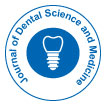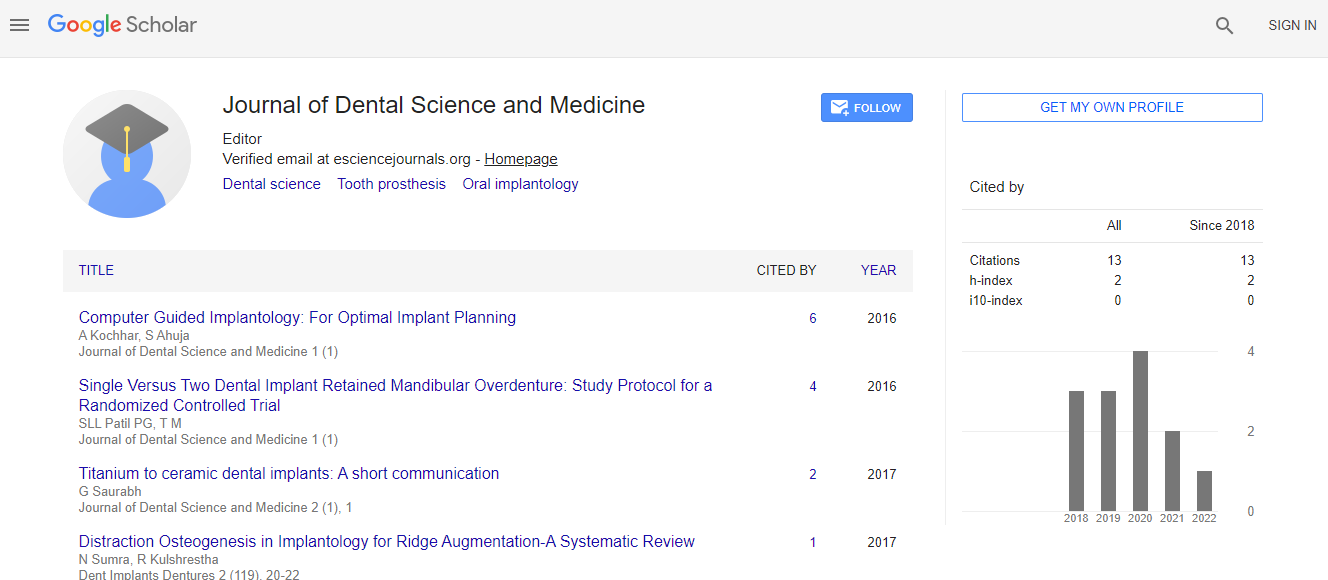Our Group organises 3000+ Global Conferenceseries Events every year across USA, Europe & Asia with support from 1000 more scientific Societies and Publishes 700+ Open Access Journals which contains over 50000 eminent personalities, reputed scientists as editorial board members.
Open Access Journals gaining more Readers and Citations
700 Journals and 15,000,000 Readers Each Journal is getting 25,000+ Readers
Google Scholar citation report
Citations : 13
Journal of Dental Science and Medicine received 13 citations as per Google Scholar report
Indexed In
- RefSeek
- Hamdard University
- EBSCO A-Z
- ICMJE
Useful Links
Recommended Journals
Related Subjects
Share This Page
The effect of extending endocrown preparation onto the outer surface of the buccal wall on marginal and internal adaptation of the final restoration
7th International Conference on Prosthodontics & Orthodontics
Zahra Abbasiparashkouh
Assistant Professor, Tehran University of Medical Sciences, Tehran, Iran
ScientificTracks Abstracts: Dental Science and Medicine
Abstract
Statement of the Problem: Endocrowns are used in the restoration of endodontically treated teeth. Due to the importance of marginal and internal adaptations, this study assessed the effect of extending preparation over the outer surface of the buccal wall on the marginal and internal adaptation of endocrown restorations. Methodology & Theoretical Orientation: In an experimental trial, 24 permanent maxillary first molars with similar crown dimensions were selected and stored in 0.5% chloramine-T after disinfection. The teeth were cut perpendicular to the long axis of 3mm above CEJ followed by root canals preparation and irrigation. The canals were obturated by gutta-percha and sealer. The teeth were fixed in a dental surveyor and the roots were mounted in autopolymerizing acrylic resin. Gutta-percha was removed from canals. Canal entries were filled by composite and pulp chamber floors were flattened. Teeth were prepared by standard method using water spray as well as a dental surveyor and a diamond bur. They were randomly assigned into 2 groups: in the experimental group, preparation was extended in buccal walls from mesiobuccal to distobuccal angle and from 3mm above CEJ to CEJ margin using a round end bur. In control group, butt-joint preparation was done. Endocrowns were manufactured by heat press method. Internal and marginal adaptations were measured by replica method. To achieve vertical perpendicular view, 2-mm cuts parallel to the walls were obtained. Light-body layer suggesting discrepancy between teeth and endocrown was assessed by 35x magnification by a digital stereo-microscope. The marginal and internal gaps of 2 groups were analyzed by Student t-test. Findings: Mean├?┬?├?┬▒standard error of internal gaps were 412.24├?┬?├?┬▒31.49 and 770.04├?┬?├?┬▒48.37 ├?┬?├?┬╝m in butt margin and preparation extension groups respectively. The values were 324.05├?┬?├?┬▒17.20 and 273.71├?┬?├?┬▒15.54 ├?┬?├?┬╝m for marginal gaps respectively. Mean internal gaps of preparation extension specimens were significantly higher than butt margin group (p<0.001) while mean marginal gaps were lower for extension group than butt margin significantly (p=0.03). Conclusion & Significance: Due to increased internal gap in buccal extension group, this type of preparation my not be the best choice in teeth with less aesthetic value. However, in case of premolars where aesthetic aims are of great importance, further studies need to be carried out.Biography
Zahra Abbasiparashkouh is passionate about investigating biomechanical mechanisms and novel dental prosthetic options, her ultimate goal being the development of a reliable guideline for treatment planning. Her evaluation of acceptability of biomechanical characteristics of novel dental materials and restoration designs leads to a more predictable and valid selection of the final restoration design.

 Spanish
Spanish  Chinese
Chinese  Russian
Russian  German
German  French
French  Japanese
Japanese  Portuguese
Portuguese  Hindi
Hindi 